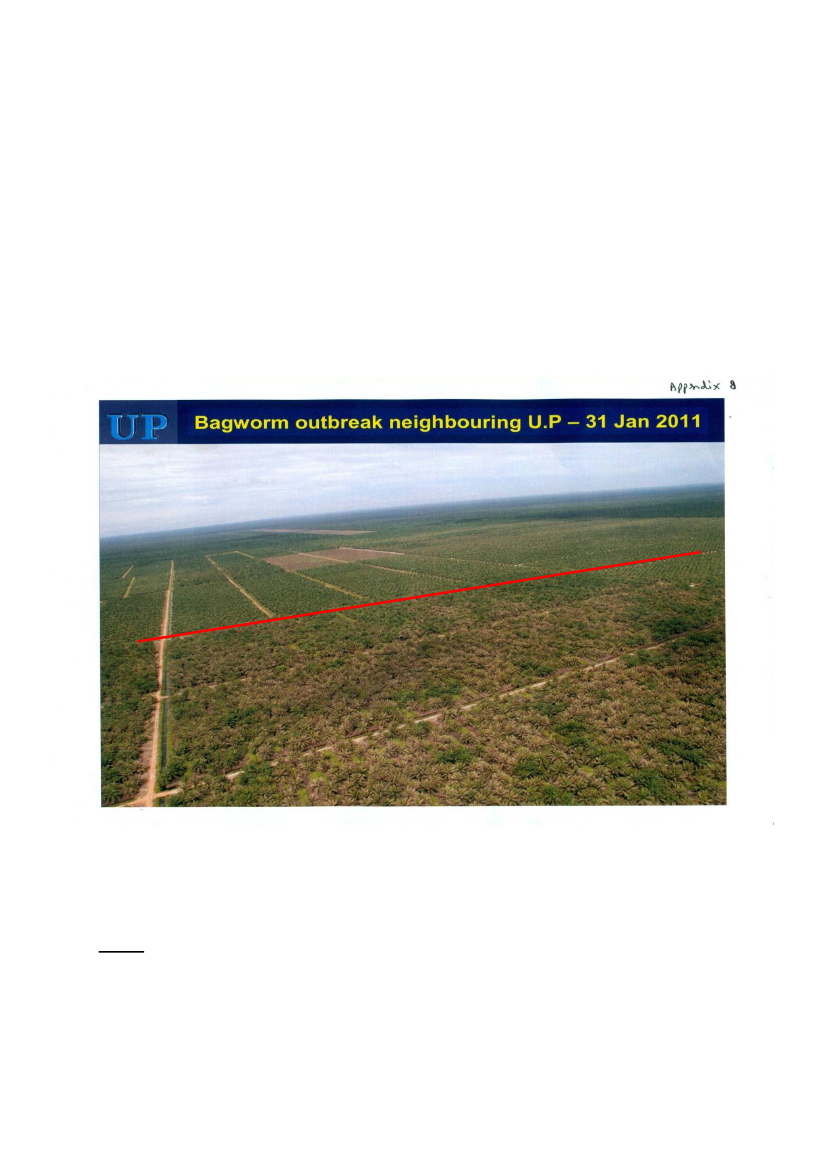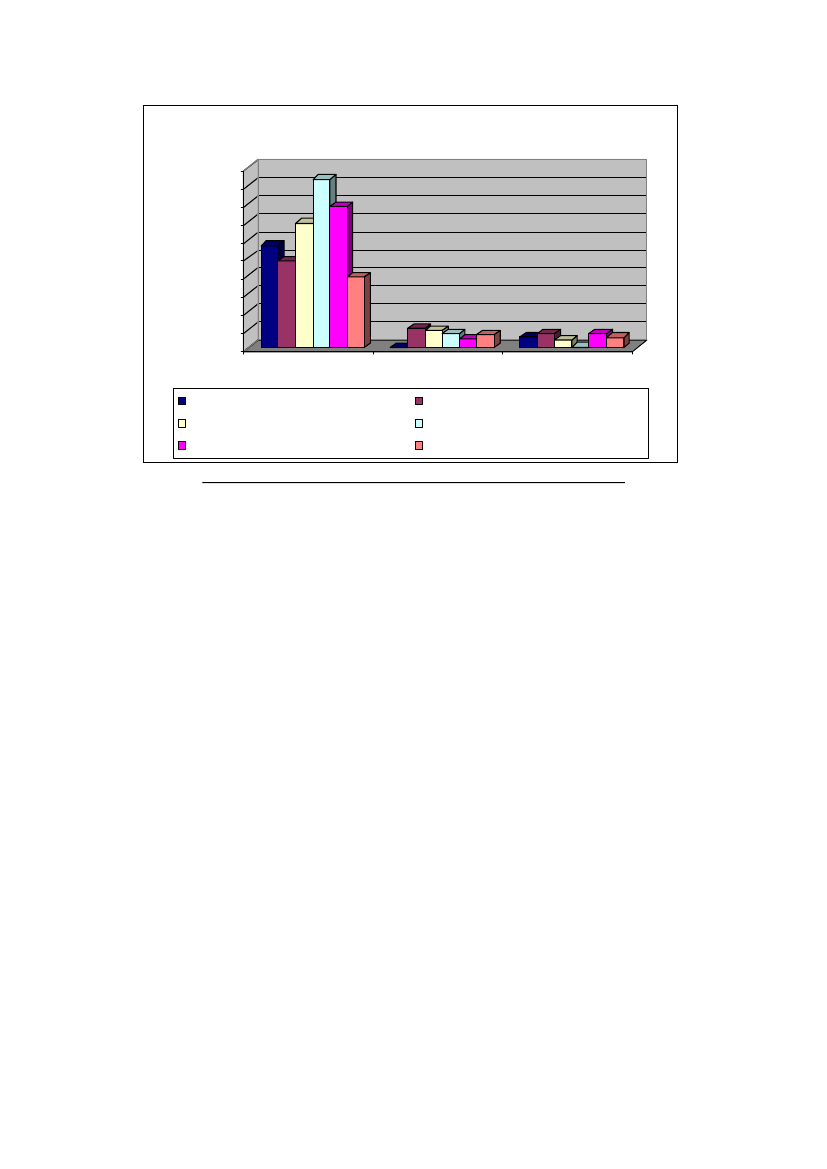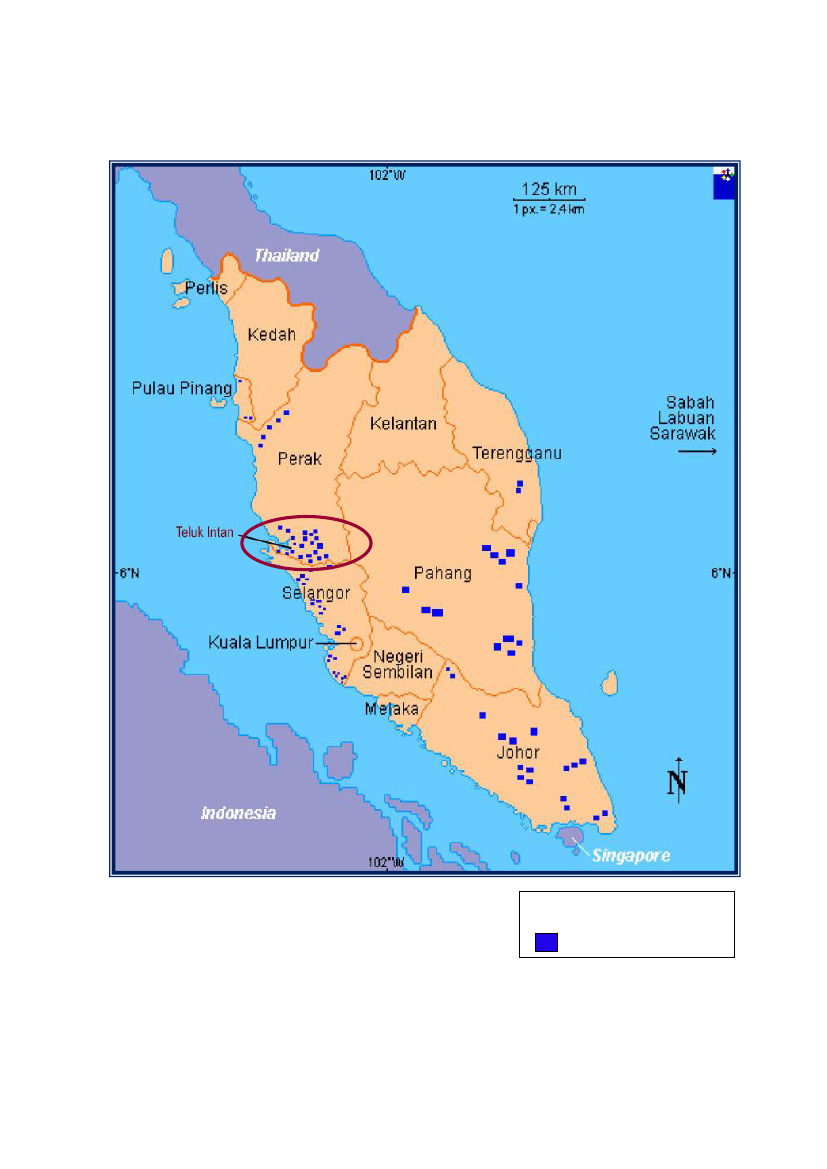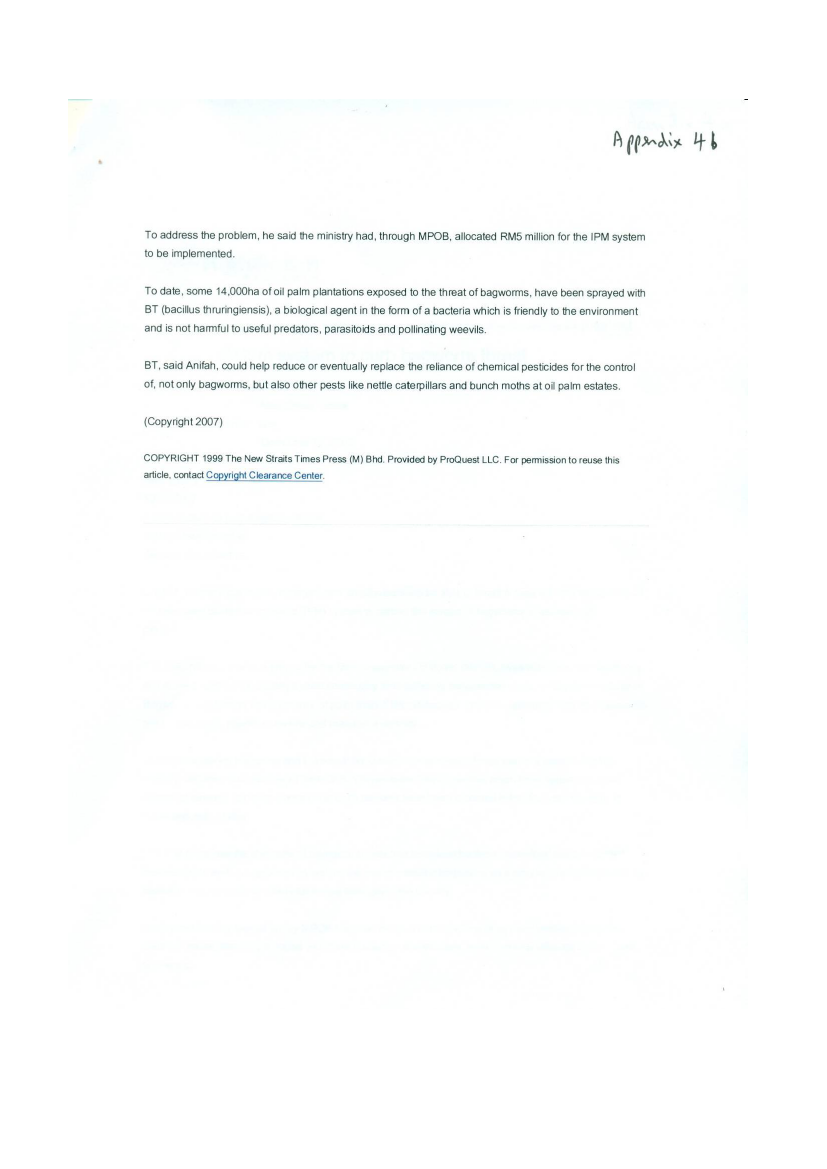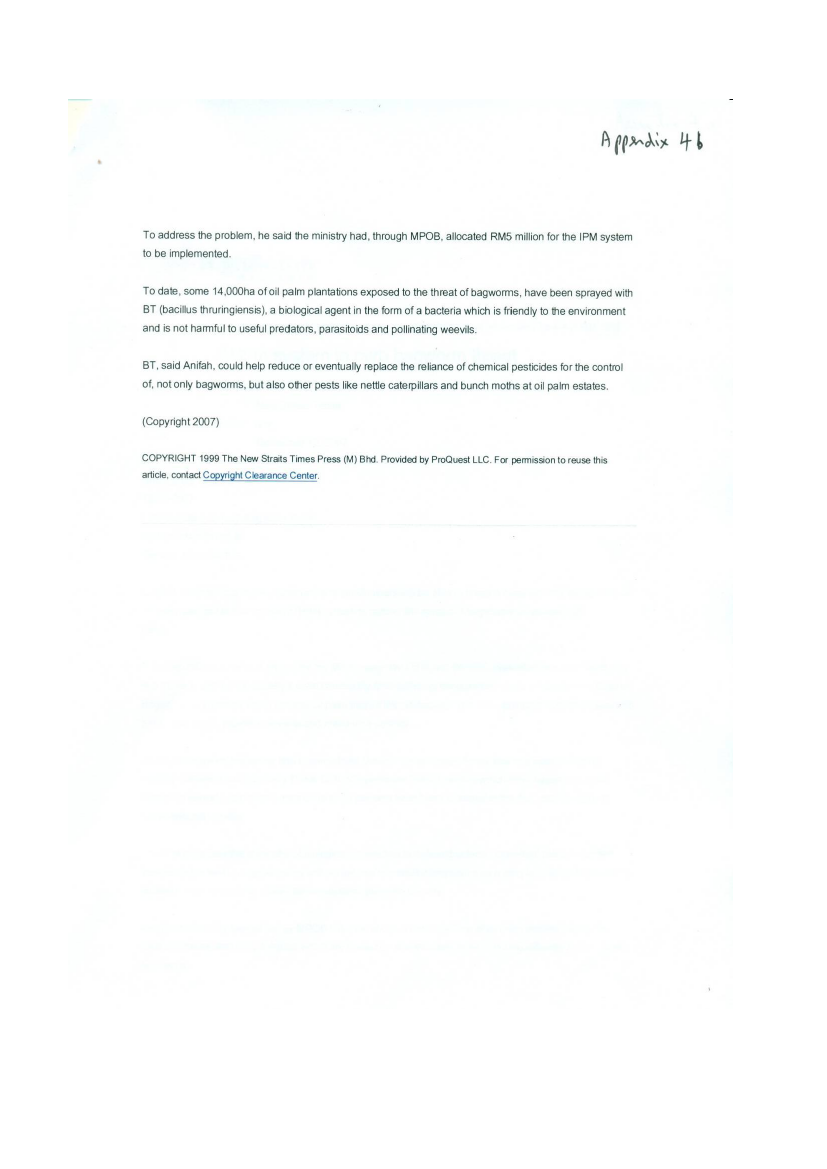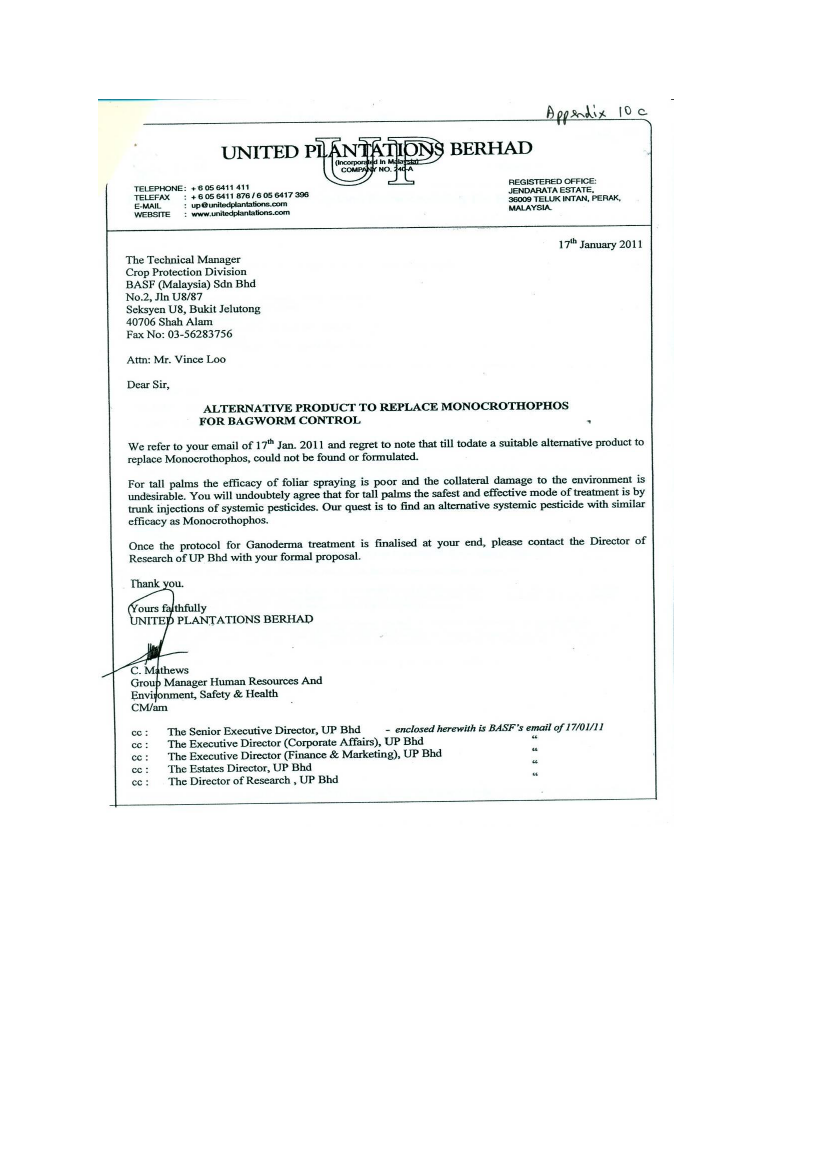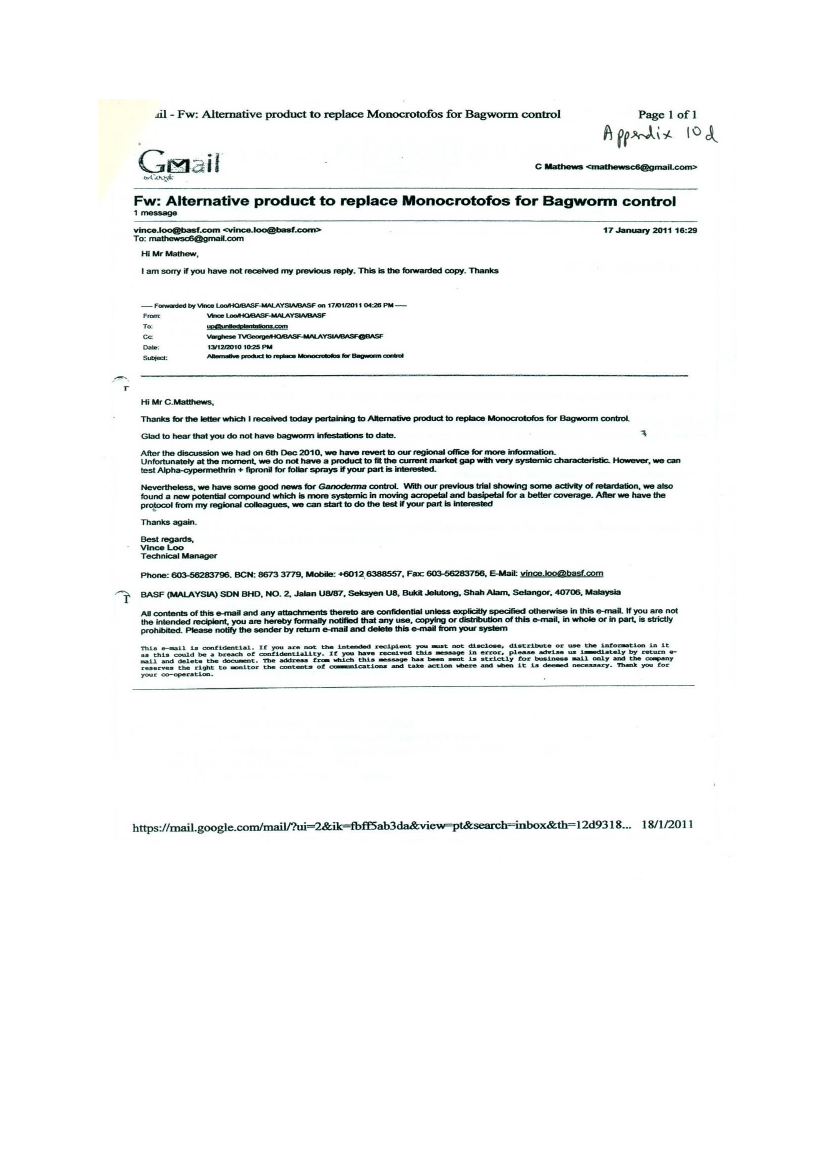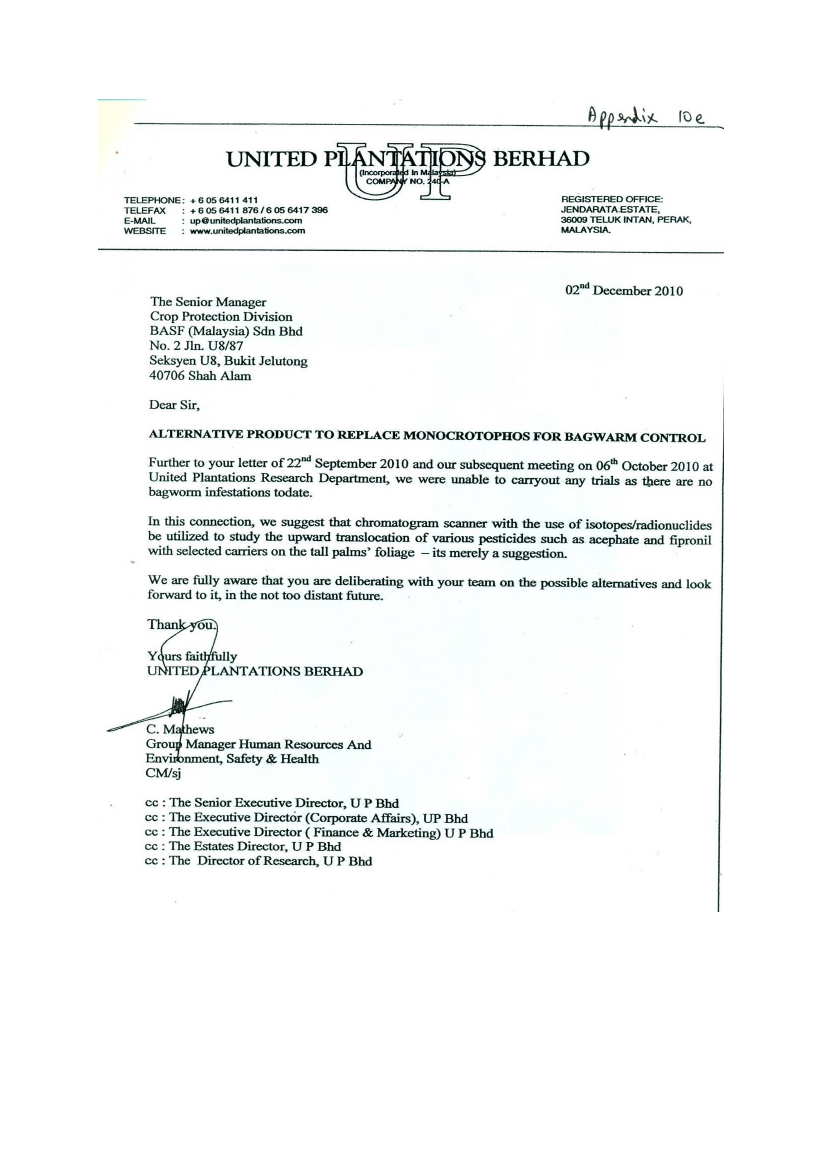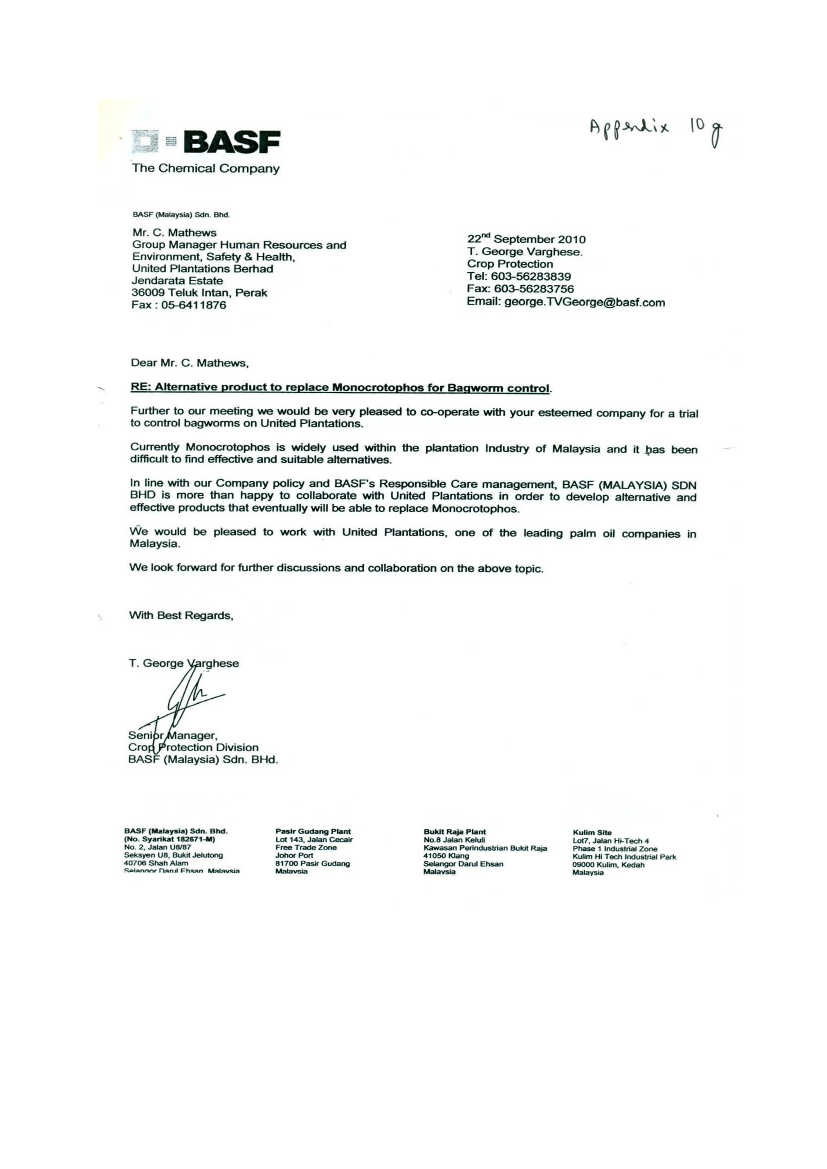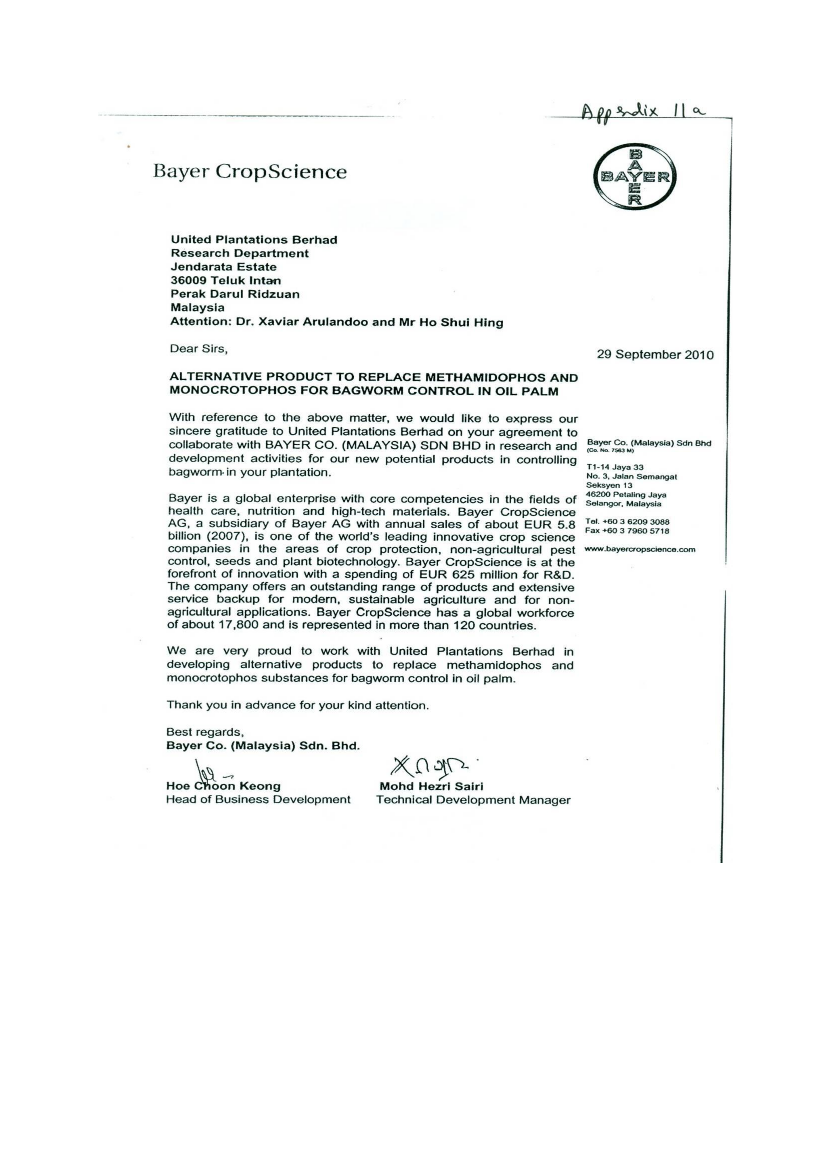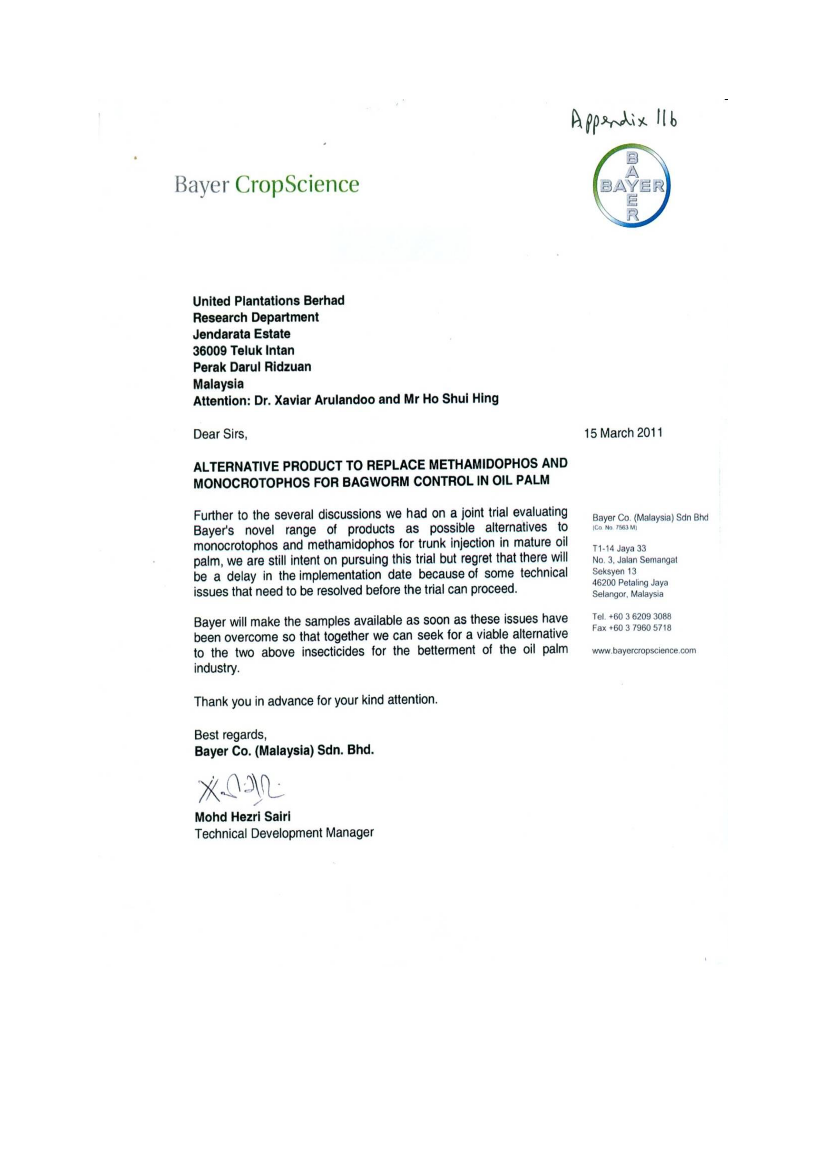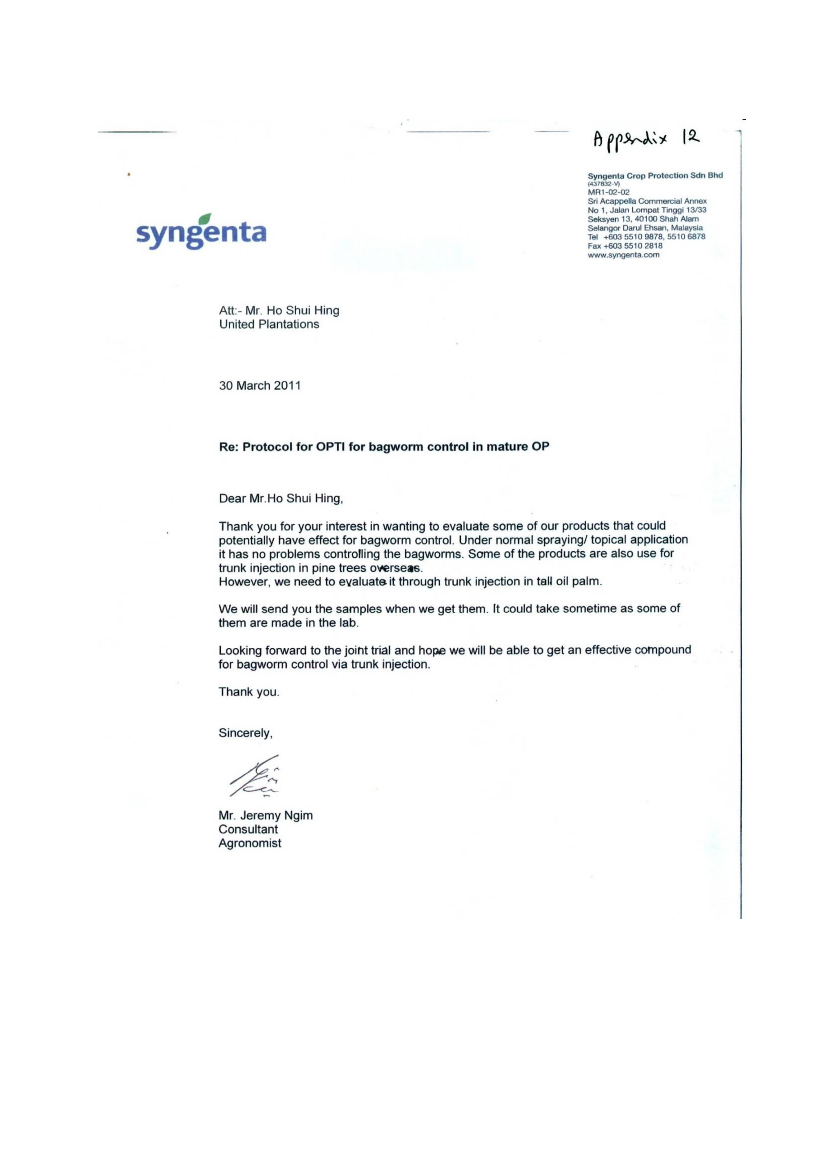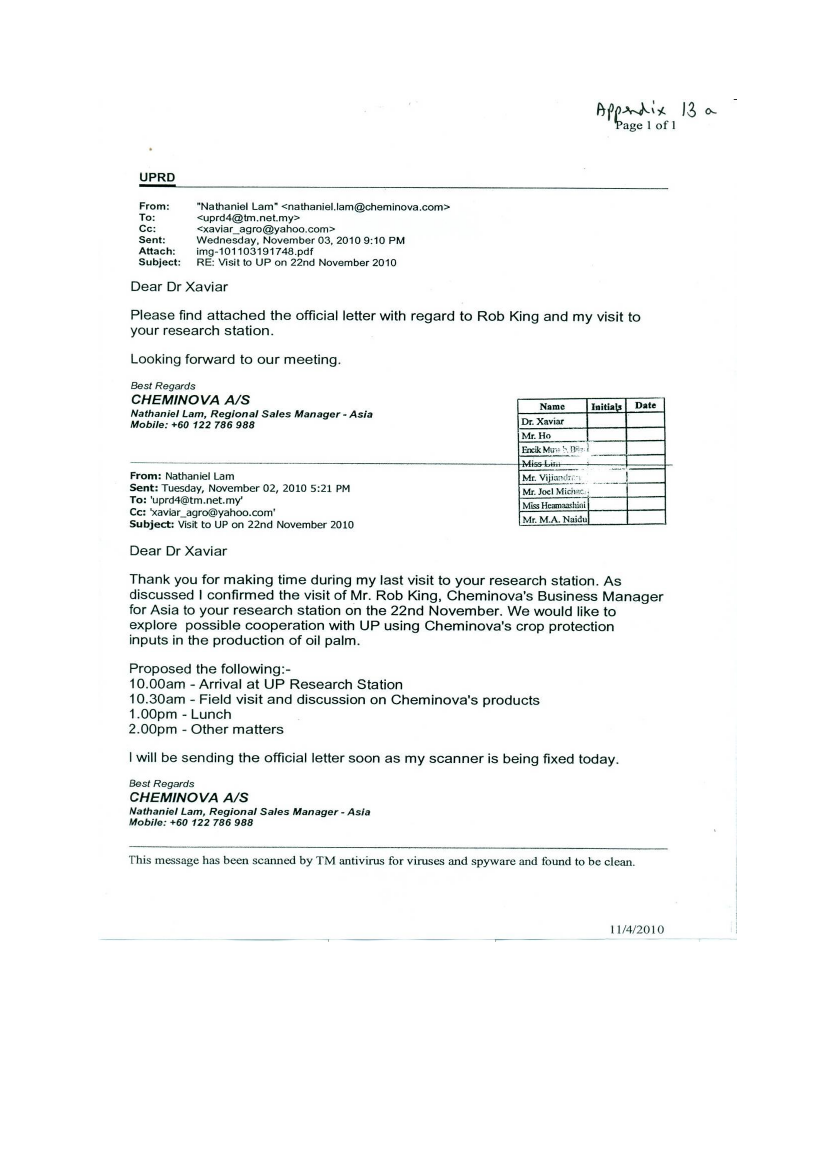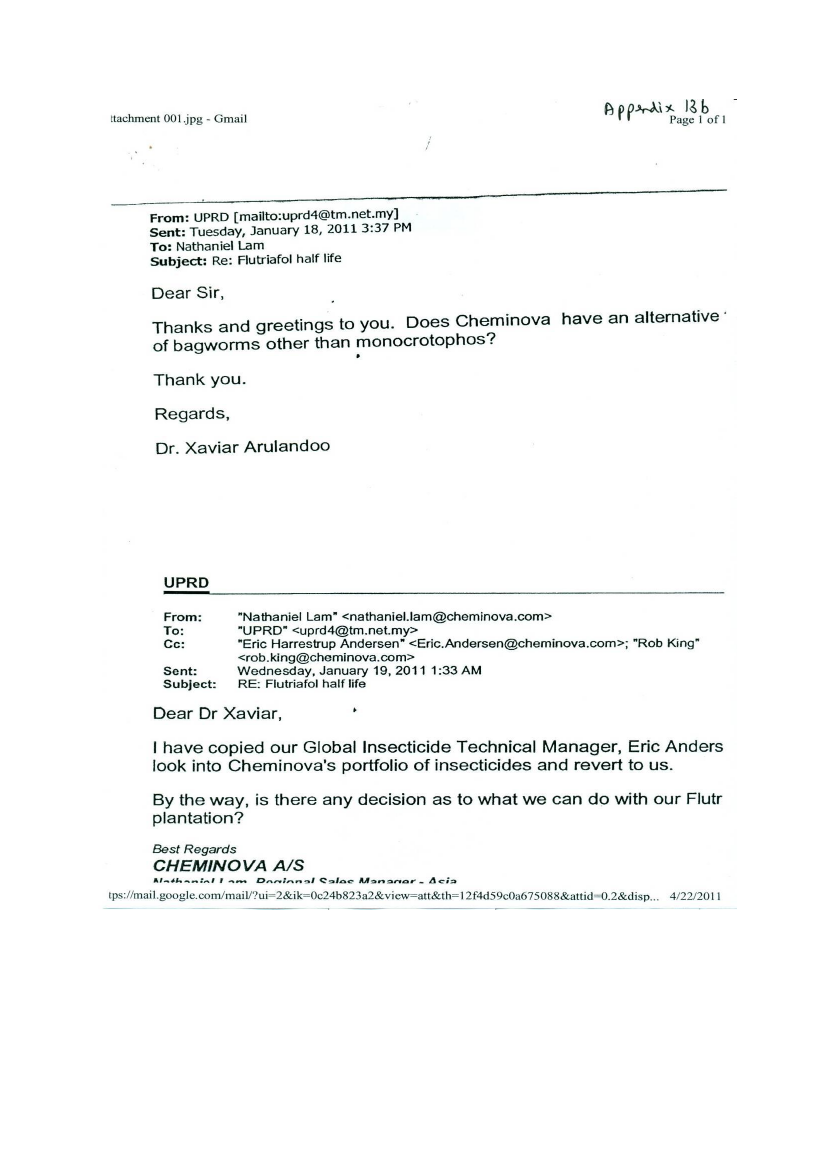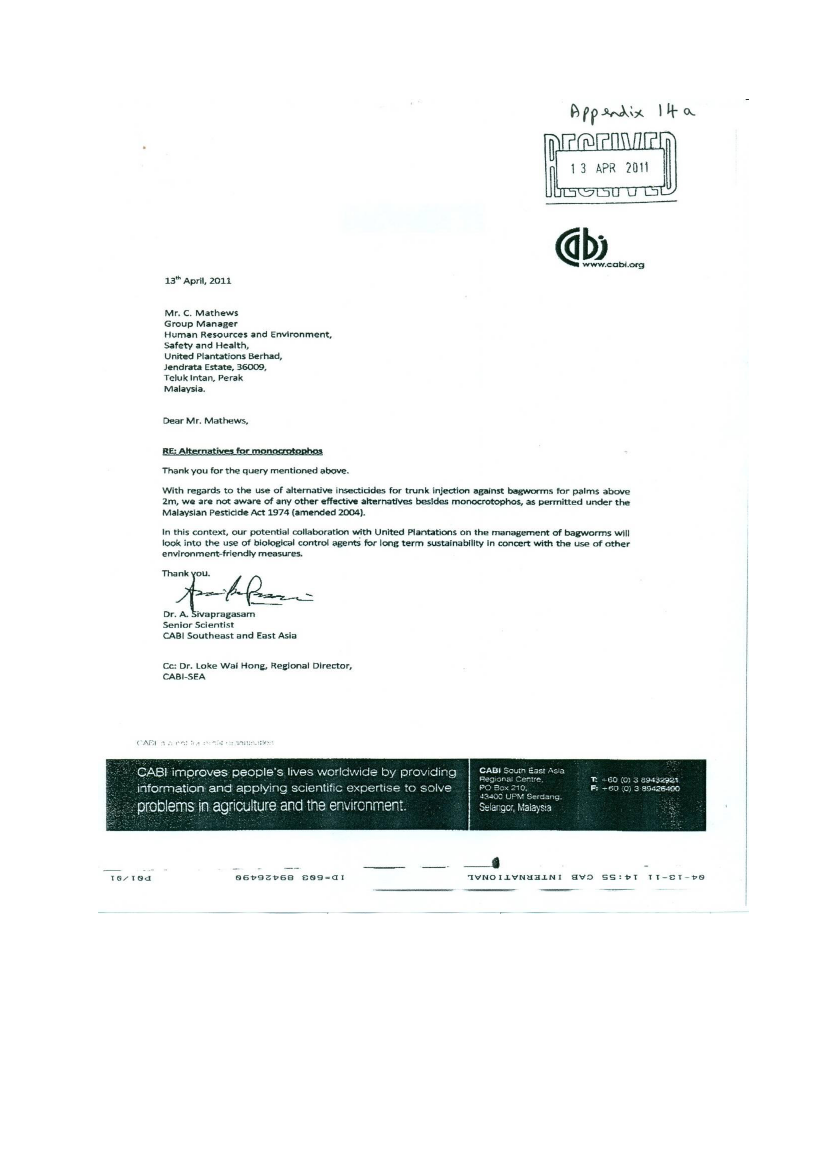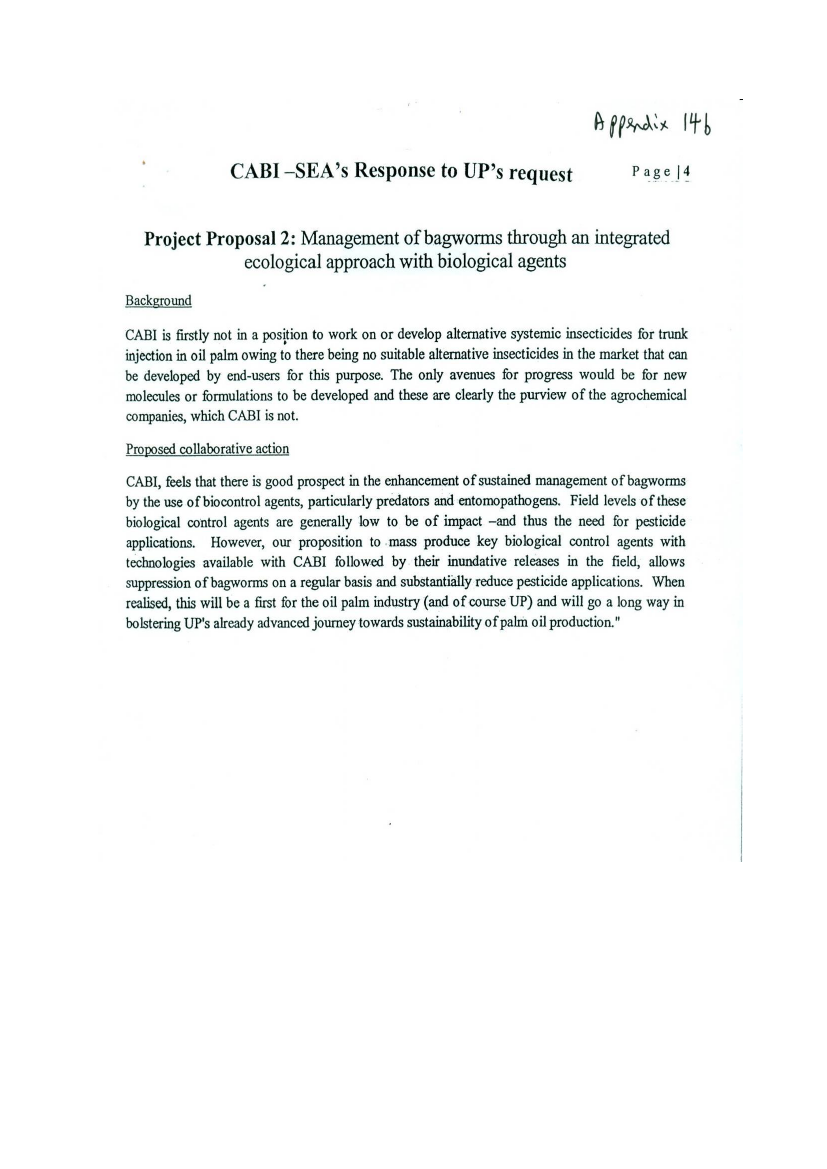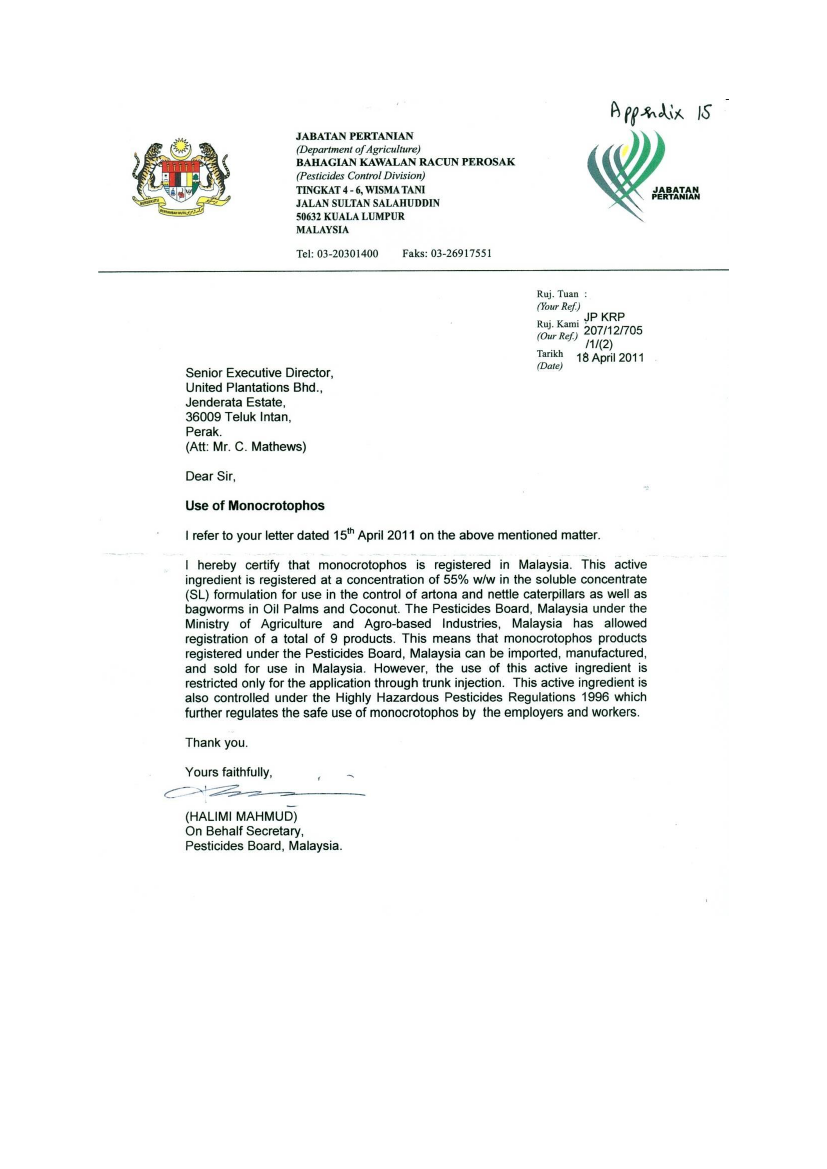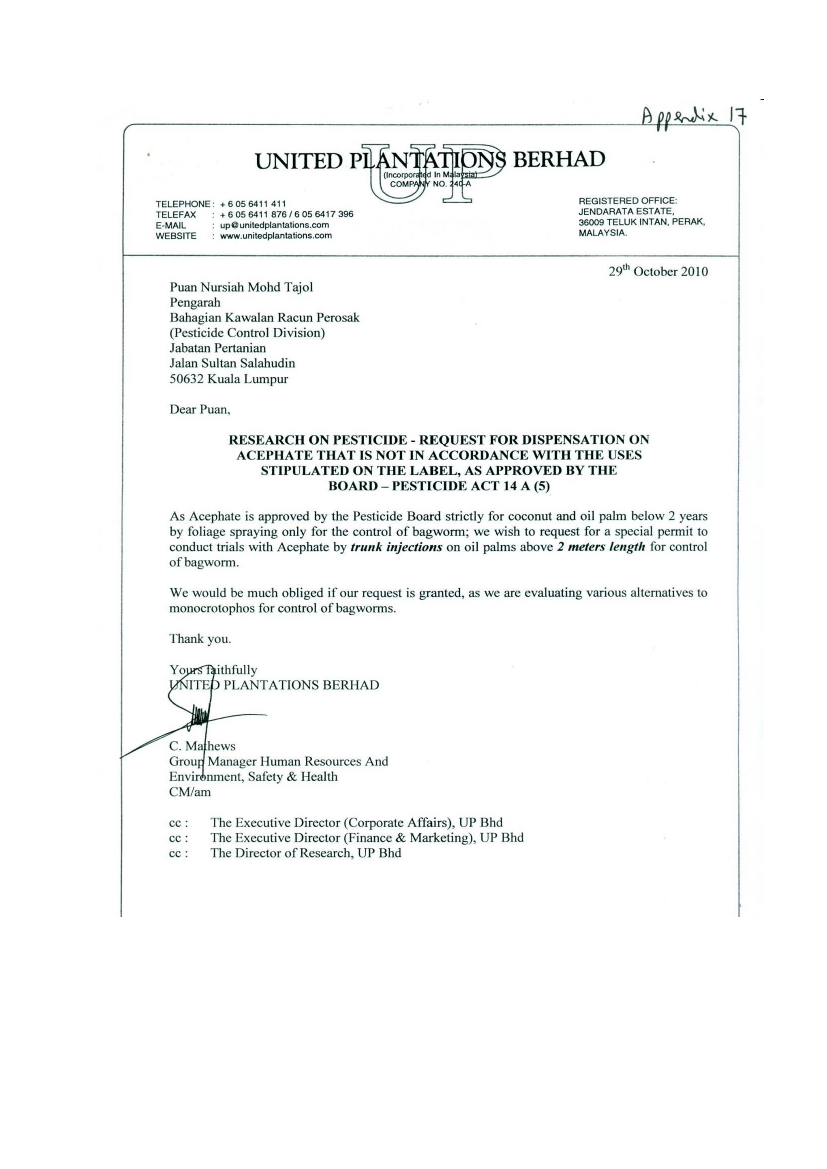Miljøudvalget 2011-12
MIU Alm.del Bilag 89
Offentligt
Meeuwenlaan 4-6office8011 BZ Zwolle (NL)P.O. Box 161postal8000 AD ZWOLLE (NL)+31 (0)38 -Phone00426 01+31 (0)38 -fax70 40423[email protected]e-mailwww.controlunion.comwebsitecci24274509NL12ABNA0468081410ibanbicABNANL2ANL806.327.789.B01vat
The use of Monocrotophos.Introduction.Control Union Certifications was instructed by the Danish Energy Agent to conduct an audit of the useof Monocrotophos by United Plantations Bhd.Executive summary.Monocrotophos is used for the effective control of Bagworm Caterpillars in oil palmplantations.It is approved for use by the Malaysian Palm Oil Board and currently there are no effectivealternatives.United Plantations have been actively trying to source and to evaluate alternatives toMonocrotophos since 2006 and another trial project has been recently initiated by UnitedPlantations to find a natural biological control in co-operation with CABI (CommonwealthAgricultural Bureaux International).The use of Monocrotophos has been demonstrably reduced over the past 4 years but a lack ofcontrol of Bagworm Caterpillars on neighbouring estates is resulting in increased numbers(and associated attacks) despite very sound control methods being implemented by UnitedPlantations.The use of Monocrotophos is only used as a last resort after all known biological controls havebeen exhausted.
Background.Oil palm is a major agricultural crop with significant economic, environmental and social benefits forMalaysia. Like any agricultural crop, it is susceptible to attack by a wide range of pests and diseasessome of which are of greater threat than others.Two leaf eating pests are the Bagworm and Nettle Caterpillars which can devastate significant areasof oil palm if not detected and treated in the very early stages of an out-break. Of these two theBagworm Caterpillar (referred to as Bagworms) is the most damaging.Responsible growers take a pro-active approach to controlling Bagworms by carrying out regular fieldinspections and by planting a range of beneficial plants. These plants encourage predators of theBagworms by providing nectar and shelter and represent an indirect bio-control system known asIntegrated Pest Management (IPM).Fortunately Bagworms are not a wide spread problem for the oil palm industry but in 1988 the Palm OilResearch Institute of Malaysia (now known as the Malaysian Palm Oil Board – MPOB) conducted asurvey and identified the lower areas of Perak State to contain endemic levels of Bagworms. Seeappendix
In the survey, 29 out of 113 respondents reported Bagworm outbreaks. This represents 26% of the oilpalm estates in Perak State and is double the national average of 13.5%. Members of the MPOBreport monthly on the total area of oil palm infested and the return for October 2010 show that out of58,185ha, 13,847 ha were infested in the Perak State.In 2007, the Deputy Plantation Industries and Commodities Minister reported that 33,475ha of oil palmin lower Perak State were seriously affected by Bagworm outbreaks. As a result, a Governmentsubsidised aerial spraying program was initiated but the number of Bagworms is again on the increasein part due to the lack of control by some estates and many smallholders.United Plantations manage about 35,791 ha of oil palm in lower Perak State and an aerial surveysttaken on 31 January 2011shows that the infestation of Bagworms in neighbouring properties is ofsignificant threat to United Plantations. It is noted that airborne Bagworm larvae can spread overseveral kilometres over-time and that one male and one female can become 843,000 bagworm within6 months – assuming no natural mortality.This photograph shows the outbreak of bagworm in estates that adjoin United Plantations.
UP Plantations
Neighbouring Estates infected withbagworms
Following this reconnaissance, a second aerial reconnaissance was arranged for 13 managers ofneighbouring estates to United Plantations. It is noted that several of these managers were surprisedto note the extent of the bagworm outbreak on their respective properties.United Plantations subsequently arranged for training in bagworm monitoring and control techniquesfor the neighbouring estates who clearly have an obligation to control bagworm.Scope.The audit scope covered the following:The practice of pest control as conducted by United Plantations.The criteria for pest control as in the Round Table on Sustainable Palm Oil InternationalPrinciples and Criteria as interpreted for Malaysia.
www.controlunion.com
Round Table on Sustainable Palm Oil. (RSPO).The RSPO is a global, multi-stakeholder initiative on sustainable palm oil. Members of RSPO andparticipants in its activities come from many different backgrounds, including plantation companies,manufacturers and retailers of palm oil products, environmental NGOs and social NGOs and frommany countries that produce or use palm oil.The principal objective of RSPO is “to promote the growth and use of sustainable palm oil through co-operation within the supply chain and open dialogue between its stakeholders”.The RSPO Principles and Criteria for Sustainable Palm Oil Production were adopted in November2005. Malaysia prepared a National Interpretation of these Principles and Criteria and this wasendorsed by the RSPO Executive Board in 2008. There are 8 principles, 39 Criteria and 125 indicatorsused to evaluate whether an oil palm plantation and associated palm oil mill is operating inaccordance with the RSPO before a certificate of compliance can be awarded.On the 5 July 2011, there were 865,563 ha of certified oil palm across the globe producing 4,244,543mt of CPO. This represented about 10% of the supply base.There are 2 principles and some associated criteria that are related to the scope of this audit:Principle 4:The use of appropriate best practice by growers and mills.‘Criterion 4.5: Pests, diseases, weeds and invasive introduced species are effectivelymanaged using appropriate integrated Pest Management (IPM) techniques’.4.1.1:4.1.2:Documented Standard Operating Procedures (SOP) for estates and mills.Records of monitoring and the actions taken are maintained and kept for a minimumof 12 months.th
‘Criterion 4.6 Agrochemicals are used in such a way that does not endanger health or theenvironment. There is no prophylactic use, and where agrochemicals are used that arecategorised as World Health Organisation Type 1A or 1B, or are listed by the Stockholm orRotterdam Conventions, growers are actively seeking to identify alternatives, and this isdocumented’.4.6.1:4.6.2:Written justification in Standard Operating Procedures of all agrochemical use.Pesticides selected for use are those officially registered under the Pesticides Act 1974 (Act149) and the relevant provision (Section 53A); and in accordance with USECHH Regulations(2000).Pesticides shall be stored in accordance to the Occupational Safety and Health Act 1994 (Act514) and Regulations and Orders and Pesticides Act 1974 (Act 149) and Regulations.All information regarding the chemicals and its usage, hazards, trade and generic names mustbe available in language understood by workers or explained carefully to them by a plantationmanagement official at operating unit level.Annual medical surveillance as per CHRA for plantation pesticide operators.No work with pesticides for confirmed pregnant and breast-feeding women.Documented justification of any aerial application of agrochemicals.
4.6.3:4.6.4:
4.6.5:4.6.6:4.6.8:
‘Criterion 4.7: An occupational health and safety plan is documented; effectivelycommunicated and implemented’.4.7.1:Evidence of documented Occupational Safety Health (OSH) plan which is in compliance withOSH Act 1994 and Factory and Machinery Act 1967(Act 139).
‘Criterion 4.8 All staff, workers, smallholders and contractors are appropriately trained’.4.8.1:A training programme (appropriate to the scale of the organization) that includes regularassessment of training needs and documentation, including records of training for employeesare kept.
Principle 8:Commitment to continual improvement in key areas of activity.‘Criterion 8.1: Growers and millers regularly monitor and review their activities and developand implement action plans that allow demonstrable continual improvement in key operations’.8.1.1:Minimise use of certain pesticides.
www.controlunion.com
United Plantations Bhd.In 2008, United Plantations became the first plantation company in the world to be awarded theprestigious RSPO certification for all their operations in the Perak State. The process included 2 pre-assessments and a full main assessment conducted by an audit team from Control UnionCertifications.Subsequently annual surveillance audits have been conducted to confirm that the company continuesto operate in accordance with the RSPO principles and criteria and both Principles 4 and 8 wereincluded in the annual surveillance audits.Principle 4: The use of appropriate best practice by growers and mills.4.1.1: Documented Standard Operating Procedures.United Plantations has a full set of Standard Operating Procedures covering all oil palm operations.The SOP for Bagworm identification and control comprises a 5 step preventative program:1. IPM.Planting of beneficial plants to enhance the natural parasitic and predator activities against bagworm.To date more than 98,000 beneficial broadleaved flowering plants have been planted.Census gangs deployed on each estate who take random frond samples in a pre-determined pattern.These fronds are subjected to insect counts and damage assessments by trained personnel.Regular aerial reconnaissance is carried out to better detect, pre-empt and treat potential outbreaks.For example:Bacillus Thuringiensisas the first line of treatment against an outbreak.As a final resort and only when the above steps have proven to be futile.
2.3.4.5.
Monitoring and census.
Aerial surveillance.Use of biological control agents.Chemical intervention.
4.1.2:
Records of monitoring.Monitoring records of the use of Monocrotophos include:Monitoring census.Date of application.Field of application.Quantity of pesticide used and quantity of active ingredient per ha.Name of operator.
4.6.1:
Written justification for all agrochemical use.Justification for use is laid out in Field Management Manual supplements section 3.1.4.1.The use of Monocrotophos is justified as follows:It is the only effective pesticide available for the effective control of Bagworm in oil palmplantations with tall palms (3 metre total height).It is included in the Malaysian Palm Oil Board (MPOB) list of approved Pesticide for use in oilpalm plantations in Malaysia.
4.6.2:4.6.3:
Pesticides are those officially registered under the Pesticides Act 1974.Monocrotophos is registered under the Pesticides Act 1974. See also appendices.
Pesticides shall be stored in accordance to the Occupational Safety and Health Act 1994 etc.All the United Plantation chemical stores are inspected as part of the RSPO certification procedure and itis noted that they all comply with the relevant act as well as best practice.All stores are secured under lock and key with restricted access.Pesticides are separated by class and class 1 and II chemicals are further stored underseparate lock and key within the main store.Store keeper is fully trained in the handling of all pesticides.
4.6.4: All information regarding the chemicals and its usage, hazards, trade and generic names mustbe available in language understood by workers or explained carefully to them by a plantationmanagement official at operating unit level.MSDS leaflets are available in all pesticide stores. (Material Safety Data Sheet)Workers applying Monocrotophos are fully trained and aware of the hazards.
www.controlunion.com
4.6.5:
Annual medical surveillance as per CHRA for plantation pesticide operators.All pesticide operators have a monthly medical check-up.All pesticide operators undergo a comprehensive annual medical check-up which includesblood analysis.It is noted that there have been no documented cases of any operators suffering from anysymptoms of pesticide poisoning over the past 15 years.Furthermore It is noted that immediately after the allegation arose in the Danish press, aninterim and additional full medical check-up was conducted and blood analysis showneither exposure nor symptoms of Monocrotophos poisoning.
4.6.6:
No work with pesticides for confirmed pregnant and breast-feeding women.No women are employed for agrochemical application purposes. This includes both pesticides andherbicides.
4.6.8:4.7.1:
Documented justification of any aerial application of agrochemicals.No aerial application of any agrochemicals on any United Plantation estates.
Evidence of documented Occupational Safety Health (OSH) plan which is in compliance withOSH Act 1994 and Factory and Machinery Act 1967(Act 139).United Plantations have a comprehensive generic OSH plan which includes:A list and classification of all hazards – including the application of pesticides.A risk assessment for each hazard.Action to be taken to eliminate the risk associated with each hazard.Personal Protective Equipment (PPE) to be worn for all operations.Management responsible for ensuring implementation of action.Training required for each operation that is linked to the hazard and risk assessment.Regular meetings of OSH committees for each estate.Daily safety briefings for all workers applicable to their duties.Records of distribution and maintenance of all PPE distributed.
4.8.1:
A training programme (appropriate to the scale of the organization) that includes regularassessment of training needs and documentation, including records of training for employeesare kept.Training programs are prepared based upon the hazard and risk assessments and full training recordsare available that include:Date.Purpose.Details of the training.List of all participants.Photographic evidence.It is noted that for the application of Monocrotophos, dedicated and trained teams (comprising 3persons to a team) are deployed.The audit team note that the training records are comprehensive and linked to the OSH(Occupational Safety and Health) policy procedures. Interviews of workers confirmedthat the training was carried out and was effective.
Principle 8: Commitment to continual improvement in key areas of activity.8.1.1: Minimise use of certain pesticides.United Plantations were awarded RSPO certification in July 2008 and since then have under-gone 2annual surveillance audits. During these audits, their progress to reduce certain pesticides was auditedand the following findings noted with particular reference to Monocrotophos:IPM is implemented throughout all estates.The number of beneficial plants on all estates is being increased on an annual basis.In 2007 the average number of plants per ha was 1.11. There has been an increase of about260% to 2.92 plants per ha.The use of pheromone traps has increased.Across the entire United Plantations oil palm estates, the quantity of Monocrotophos hasdecreased from 0.35 kg/ha in 2006 to 0.20kg in 2009 and a slight increase in 2010 to 0.245kg/ha due to a rise in bagworm numbers on neighbouring estates which have spread into UnitedPlantations Estates.It is also noted that the use of paraquat was eliminated entirely as from October 2010 as aconsequence of a voluntary effort which commenced in February 2008.
www.controlunion.com
Research work to find an effective alternative to Monocrotophos for trunk injection.The Research Department of United Plantations has been taking a pro-active approach to source andevaluate alternatives Class 1B to Monocrotophos since 2006 and this work includes the following:1. Internal trials of 2 formulations of acephate and imacloprid.2. Active engagement of multi-national pesticide companies to source viable alternatives tomonocrotophos for trunk injection.3. Engaging CABI (Commonwealth Agricultural Bureaux International) to conduct a two yearproject to research other effective bio control methods of bagworm.With reference to each of the above:1. Internal trials.An area has been identified to carry out trials over a period from February 2011 to first quarterof 2013. The trials include the following treatments of trial plots covering 4 rows of 5 palmsreplicated 3 to 4 times:a.b.c.d.e.f.g.h.Acephate at 3.7g a.i. per palm.(5ml/palm).Acephate at 7.5g a.i. per palm.(10ml/palm).Acephate at 11.25g a.i. per palm. (15ml/palm).Acephate at 15g a.i. per palm.(20ml/palm).Imidacloprid at 10ml product per palm.Imidacloprid at 20ml product per palm.Monocrotophos at 10 ml product per palm.Untreated.
Palm census is carried out by well trained and experience staff assisted by workers to checkthe trial results. The census is carried out at each week for 4 weeks from the treatment day.The 10 most infested palms in each plot is marked and results monitored. Census includes therecording the live larvae, dead larvae, live pupae, empty pupae and dead pupae.Early results show that monocrotophos is more effective in controlling bagworm.Acephate treated palms show re-infection after 4 weeks.Trunk Injection for Bagworm ControlLSE 35A Treated 17.2.2011 P. pendula/M. plana
7
Av Live Larvae/Frond
6543210Pre-TmtWeek 1Week 2Week 4
Monocrotophos (Phoskill 10ml/palm)
Acephate (Lipat 4.4g/palm)
Table showing trial result with monocrotophos and acephate.
www.controlunion.com
Trunk Injection For Bagworm Control Trial 2LSE 35A Treated 26-28.2.2011 P.pendula/M. plana
10.009.008.007.006.005.004.003.002.001.000.00Pre-TmtWk 1Wk 2Acephate ( Duo Man Lo 10ml/palm)Acephate (Lipat 20ml/palm)Untreated
Average live larvae/frond
Monocrotophos (Phoskill 10ml/palm)Acephate (DML 20ml/palm)Imidacloprid ( Confidor 20ml/palm)
Table showing second trial result with monocrotophos and acephate.
2. Active engagement of multi-national pesticide companies.See also appendices for communications with the following companies.BASF.After several meetings between United Plantations and their R &D personnel, BASF indicated they areyet to formulate an alternative to replace monocrotophos. (Appendix 10).
Bayer Crop Science.Active discussions are on-going between United Plantations and Bayer Crop Science to test a range ofexisting and novel Bayer products for their efficacy in trunk injection for bagworm control. Bayer is stillworking on the technical stability of their products before commencing the trial. (Appendix 11).
Syngenta.Several discussions have been held between United Plantations and Syngenta to seek for alternativeinsecticides to replace monocrotophos. Whilst Syngenta indicated they have some experimentalcompounds that can be tested for trunk injection, they have written to request for more time before thesamples are available for testing. (Appendix 12).
Cheminova.Having met with Cheminova’s Business Manager for Asia and their Malaysia Head we had enquired ifthey have any alternatives to monocrotophos. To-date United Plantations have not received anyindications from them on this subject. (Appendix 13).
3. Engaging CABI to conduct a two year project to research other effective bio controlmethods of bagworm.It is anticipated that an agreement will be entered into with CABI for a collaborative trial tobreed and release predators as biological control agents for bagworm.This project is expected to last for a period of 2 years and interim results are not expected untilthe third quarter of 2012.
www.controlunion.com
Appendices.
The geographical distribution of bagworm outbreaks in Peninsular Malaysia
KeyBagworm outbreak areas
www.controlunion.com
www.controlunion.com
www.controlunion.com
www.controlunion.com
www.controlunion.com
www.controlunion.com
www.controlunion.com
www.controlunion.com
www.controlunion.com
www.controlunion.com
www.controlunion.com
www.controlunion.com
www.controlunion.com
www.controlunion.com
www.controlunion.com
www.controlunion.com
www.controlunion.com
www.controlunion.com
www.controlunion.com


